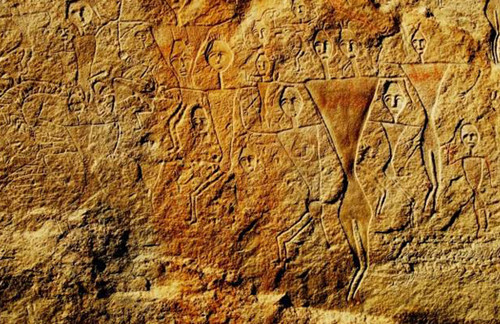Tianshan Mountains: a highway connecting ancient East and West
Author : WU XINHUA Source : Chinese Social Sciences Today 2017-11-21

Cliff paintings at Kangjia, Changji Hui Autonomous Prefecture in the Xinjiang Uygur Autonomous Region
Tianshan means “heavenly mountain” in Chinese. As an uplifted landform in the broad, extremely dry and desertified middle Eurasian continent, the Tianshan Mountains created a major highway junction where ancient civilizations interacted. Tianshan, as well as its water and vegetation, safeguarded the large-scale ancient communication processes that occurred between the East and West.
Unlike the other two cross-border mountain ranges in the middle Eurasian continent—the Altai Mountains and the Kunlun Mountains—the Tianshan Mountains mostly located in Western China, are covered with water and grass, especially on its Northern slope, as well as basins and valleys.
Stretching eastwards into the middle of Asia, from the North of the Pamir Mountains, the roof of the world, Tianshan divides the world’s driest region in two, forming a bridge between the two sides of Asia. The rivers where valley brooks gather have shaped several oases in the deserts on both sides of the mountain, giving rise to the grasslands zones that feed local civilizations. The Tarim River, which is more than 1,000 kilometers long, runs from west to east, collecting the water of melting glaciers in the Tianshan Mountains.
As a result of its natural environment, Tianshan provides both water and grass for long travels both along the Tarim River and along the oases, which eventually formed an ancient highway in the dry midland of Eurasia, far from oceans.
The eastern and western ends of the Eurasian continent gave birth to several great civilizations in human history, including the Chinese, Indus, Mesopotamian, Mediterranean, Egyptian and other civilizations.
Historically, the scattered oases in the south and stretching oases and grasslands in the north of Tianshan served as paths for trade, military activities and cultural communication between regional civilizations in the Eurasian continent. Relics of the immigration of the trade caravans, monks, soldiers and tribes are found from time to time along the paths.
The two trade roads along the clusters of oases on both sides of Tianshan stretch westward, aligning the western trade network and allowing for communication with India, Iran, Western Asia, Europe and Northeastern Africa. The roads also stretch eastward to the eastern part of the Mongolian Plateau and southeastward to the Gansu Corridor in China, therefore reaching the southern part of the Mongolian Plateau and Central China.
The trade roads also changed the desert oases and Tianshan grasslands. The previous semi-agrarian and semi-stockbreeding socioeconomic model in this region has been transformed into a largely agrarian one. Meanwhile, trade played a significant role in local development. The oases became transit markets and post stations for trade caravans. The towns and villages in large oases have developed into business cities.
The commercial benefits of the logistics trade between different civilizations in the Eurasian continent also contributed to the accumulation of wealth in these oases, which transformed them into oases business kingdoms in about the second century BCE. The culture of these external civilizations also fused with local cultures.
However, the trade routes were separately controlled by individual kingdoms along the roads. Emperor Wu (156-87 BCE) of Han Dynasty sent Zhang Qian (164-114 BCE) as an imperial envoy to communicate with the kingdoms in West China and Central Asia, the barriers to trade on both sides of the Tianshan Mountains were gradually removed. After Zhang’s diplomacy removed those barriers and the Silk Road entered a new stage of prosperous development.
Wu Xinhua is a research fellow from the Institute of Archaeology at the Chinese Academy of Social Sciences.
Ye Shengtao made Chinese fairy tales from a wilderness
Ye Shengtao (1894–1988) created the first collection of fairy tales in the history of Chinese children’s literature...
-
How northern ethnicities integrated into Chinese nation
2023-09-18
-
Mogao caves
2023-09-12
-
Mogao Grottoes as ‘a place of pilgrimage’
2023-09-12
-
Time-honored architectural traditions in China
2023-08-29
-
Disentangling the civilizational evolution of China
2023-08-28
-
AI ethics in science fiction
2023-08-23














 2011-2013 by www.cssn.cn. All Rights Reserved
2011-2013 by www.cssn.cn. All Rights Reserved